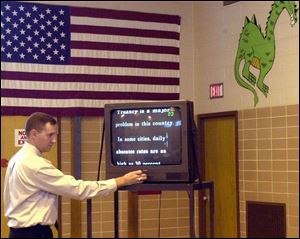
Springfield fights truancy Program grows to include more schools
10/2/2002
Dorr Elementary Principal Troy Armstrong discusses reducing school absenteeism.
A Lucas County Juvenile Court program to curb absenteeism in the schools is working so well in the Springfield Local district that school administrators plan to add it to all its elementary schools.
Cynthia Beekley, superintendent of Springfield schools, pointed out that when the mediation service started at Dorr Elementary in 1994 in an attempt to reduce the number of cases brought to juvenile court involving children who were skipping school, the absentee rate there was about 10 percent. Last year the rate was around 3 percent, she said.
“We do believe it's having a positive impact,” she said.
Dorr was one of the first to use the mediation system, along with Eastside Central, Riverside and Sherman elementary schools in the Toledo system. It was later expanded to include Springfield Middle School.
Sometimes parents don't understand how important it is for children to attend classes each day, Dr. Beekley said.
After they've missed a day or two, “it's harder for them to get into the swing of the classroom.”
That can give the youngster another reason to avoid going to school, and an unhappy cycle begins, she said.
There's a “formal informality” to meetings between parents and teachers dealing with a child's absenteeism, which is part of why the Lucas County Juvenile Court program is showing positive results.
Tammy Martin-Kosier, director of the mediation program, said the meetings aren't confrontational, but because they are a court function held with a court-appointed mediator at the school, there is a seriousness that usually get the attention of both parents and pupils.
Ms. Martin-Kosier said the program concentrates on elementary schools and often in the earliest grades.
“If you wait until high school, it may be too late. In some cases it really is too late. Even if you could get some to go back to classes,” they've missed too much to catch up.
The juvenile court uses people trained in mediation to meet with parents and teachers and sometimes include the pupil in trying to reach an agreement on how to get the child to go to class.
Ms. Martin-Kosier said that the reasons for absenteeism are diverse, but if the mediator can establish communication between the parties, there's a good chance of success.
“Sometimes it can be as easy as getting them an alarm clock,” she said.
There may be a lack of resources in the family, which parents find embarrassing, and there may be a lack of understanding what services are available at the school for a family with financial difficulties, she added.
Juvenile Court Judge Judge James Ray said that often parents may have had a bad experience in school, “and assume that the school doesn't care.”
Through the mediation session, “they are heartened to learn that the teacher does care about the education of the child.”
He said that parents who don't cooperate could be found guilty of contributing to the unruliness of a minor and be sentenced to up to six months in jail.
If a child continued to disregard a court order to go to school there could be a finding of delinquency and the child could be sentenced to a detention facility.
“I don't like to criminalize truancy,” and would much rather the mediation program resolve the problem, Judge Ray said.
Dorr principal Troy Armstron said the school usually calls on the program after a child has missed five days of school without an adequate excuse.
In most cases the problem is resolved, but if it continues the school usually tries one more session.
If truancy persists, “it's referred to the court where it goes right on top of the pile for immediate attention.”
Ms. Martin-Krosier said the cases are taken up quickly by the court because of the preliminary work done at the school level.
Within the five schools using the program, there were 268 students identified for the mediation service in the school year 2000-2001.
Only one session was required for 205 of them and 11 went through a second mediation. The cases of 21 were referred to court and there was no statistical track taken for the remaining cases, according to court records.